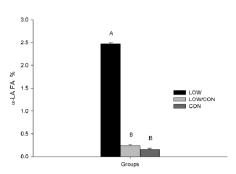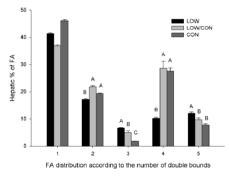Our study evaluated how the consumption of diets with low (LOW group - 0.4/1) or high (CON group - 13.6/1) omega-6/omega-3 ratio across generations (F1 and F2) can modulate liver fatty acid (FA) profile and blood biomarkers. Liver content of α-linolenic acid was higher in animals always fed with LOW diet than animals that changed from CON to LOW diet, which by your time was higher than animals always fed with CON diet. Liver saturated FA concentration decreased in both groups from F1 to F2. In conclusion, both diets were efficient in decreasing the saturated FA liver content across generations, the LOW ratio diet was more effective in reducing blood triglycerides and non-esterified fatty acids, and there was a multigenerational effect of the LOW ratio diet, improving the FA profile even when the offspring start receiving the CON diet.
Alpha-linolenic acid; essential fatty acid; lipid; metabolism; nutrition; rats




